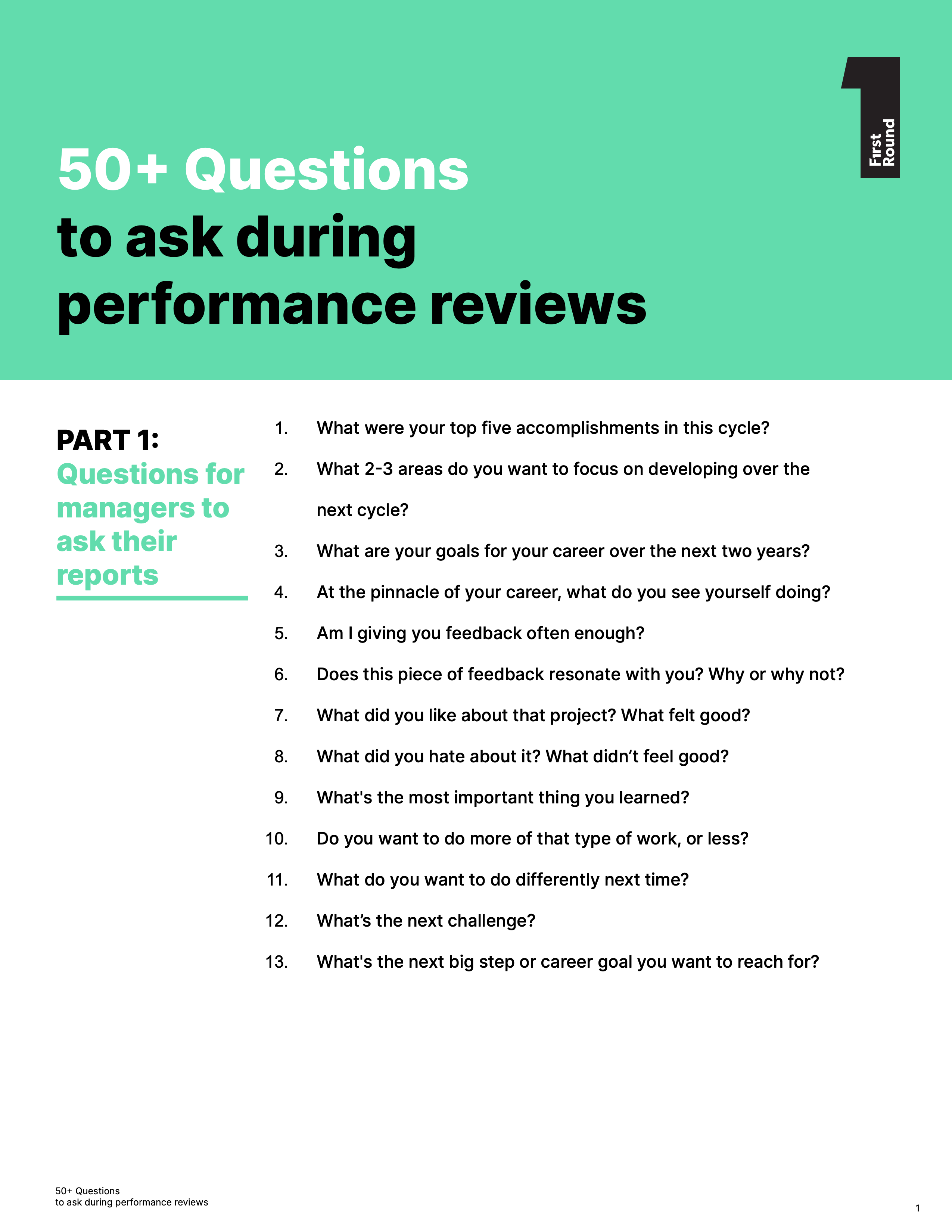The email hits your inbox, and you let out a little groan: It’s time, once again, for performance reviews. On top of your already jam-packed to-do list, you’ve now got to set aside time for writing thoughtful reviews for peers, managers, reports, and yourself — trying to patly summarize 3, 6 or 12 months’ worth of feedback, growth opportunities and accomplishments.
Not to mention the dread when it’s time to actually sit down and have these conversations. For folks on the receiving end of the review, there’s the creeping anxiety that you’ll get a dose of feedback that stings or catches you on the back foot. And for managers delivering employee reviews, there’s a delicate balance between encouragement, coaching and tough love. Let’s face it — there’s a lot of anxiety on both ends of the table.
But it doesn’t have to be such a chore. When done well, performance reviews are an incredibly valuable exercise that enables a manager and direct report to track growth over time, align on how the work impacts what matters most to the business, and build a more open and trusting relationship. The conversation should flow both ways — a back-and-forth dialogue, not a lecture.
That’s why we combed the Review archives for the best frameworks and advice we could find for both managers and direct reports to make performance reviews a worthwhile — not just headache-inducing — endeavor. From the documents to use to prep for these conversations ahead of time, to the question prompts that yield insightful conversations, to reflection tools that put feedback into practice.
We also reached out to a bunch of sharp folks in the First Round community for their best tactics on delivering feedback more effectively and how to take the constructive criticisms delivered in stride.
There are plenty of put-to-use-right-away ideas to try, whether you’re a newer manager tackling your first performance review, an experienced leader trying to level up, or a direct report who’s looking to make the most of this valuable time to drive a purposeful career conversation.
If you're looking for a targeted guide to approaching performance management with more intention, we've assembled a handy list of 50+ questions for managers and reports to ask (of themselves and each other) during these important conversations. Download the PDF below.
1. HONE YOUR NARRATIVE WITH A PERSONAL PRESS RELEASE
As you sit with the blank cursor, trying to conjure up what you accomplished since the last review cycle, it’s always tricky trying to parse which highlights and projects make the cut for your self-evaluation. This is your opportunity to showcase your chops — but without careful consideration, recency bias can quickly take over and you miss the chance to spotlight your most impactful contributions.
Over the course of her time as an early employee at Stripe and Figma (and now as a marketing lead at LangChain), Brie Wolfson has honed a personal collection of docs and templates that help her stay more focused, balanced, context-aware, and in control of her workflow on a daily basis. Her full list of 10 impactful docs is well worth exploring, but the personal press release exercise is perfect for performance review prep.

Imagine you’re writing a press release about all the things you shipped and the impact that they had. Some things you might want to include in your press release are:
- Headline/Lede: the attention grabber
- One-line summary: imagine how someone would describe this to a colleague
- Top 3-5 things you shipped
- Where your time went
- Key insights or learnings
- Progress on metrics
- Qualitative impacts
- Contributions to the broader team/company
- Positive feedback you received from stakeholders/users (internal or external)
- One piece of art (graph, picture, screenshot, etc.)
- Overall mood/sentiment
- Anything the broader organization did that you wish you could have been a part of
- What you’re really proud of
- Anything you’re not so proud of
- A look ahead on: What you’re shipping next, what you’re excited about, big opportunities for you, your team, or your company, and any foreseen blockers, risks, or things that you’re worried about.
Here they are in a template so you can get to work on your own press release.
While you likely won’t share this exact press release with your manager during performance reviews, setting aside a couple of hours for this exercise can help you craft the narrative for what you’d like to highlight in your self assessment as notable accomplishments, growth opportunities, and goal setting for what you’re excited to tackle next.
2. MANAGERS TRY THIS TEMPLATE TO STRUCTURE YOUR NEXT REVIEW CONVERSATION
ICs aren’t the only folks who can struggle with the blank page paradox — managers, too, can be unsure exactly where to get started when structuring reviews for their direct reports. That’s why we love this simple, yet powerful performance review template from Lenny Rachitsky, which he borrowed from one of his first managers when he was a young PM at Airbnb (long before he became the brains behind the eponymous Lenny’s Newsletter and Lenny’s Podcast).
“The clarity of his feedback, the care in his delivery, and the simple organization of his framework all came together to create a career development experience unlike any I’d ever had before. This set me on a course that catapulted me from a newly-minted IC PM to a manager of a half-dozen PMs, tackling everything from marketplace quality to growth, most recently building out and leading a cross-functional 80-person team driving supply growth at Airbnb,” says Rachitsky.
Done well, performance reviews improve performance, align expectations and accelerate your report’s career. Done poorly, they accelerate their departure.
This template forms the foundation of the performance management system, and we’ll walk through each section in detail below. Here’s the Google Doc version of the template for your own easy use.
Accomplishments
“Detail the person’s accomplishments over the course of the period. Collect these from the report’s self-evaluation, peer feedback, and your own notes that you’ve been keeping throughout the year,” says Rachitsky. Each item here should be significant and meaty — think hitting team goals and deadlines, not holding meetings or going to conferences. In this same section, Rachitsky also likes to include a sampling of the positive feedback he collected from peers, ideally three to five of the best quotes about the person (anonymized of course).
Superpower
“Most performance reviews over-index on development areas. The reality is that an individual will have just as much impact (if not more) on an organization if they flex what they are really good at, instead of just trying to improve on the areas they’re struggling with. Here, you have a chance to highlight that,” says Rachitsky. Describe their biggest superpower, and how they can flex it further. A few examples of superpowers that he’s highlighted in the past include a special knack for storytelling, execution, or galvanizing team members.
High-level feedback
“Next, I take a step back and summarize the report’s performance in a short narrative, about four to six sentences. I try to make a simple story arc, starting by describing how far they’ve come, then a sentence or two about how they did this cycle, and ending on a high-level overview of what they need to focus on next,” he says.
Development areas
Identify one to two development areas to focus on for the next cycle, and put them in the middle column. Don’t go overboard — less is more, so select with care. “A common mistake here is including too many development areas (more than two makes it very hard to make meaningful progress on any), or not making the development opportunities concrete enough (where your direct reports are left guessing at what you really mean),” says Rachitsky.
Here are a few specific suggestions for how to nail these down:
- What is most holding the person back from the next level? If your company has a leveling system, leverage it to explain your thinking.
- Do any clear themes emerge from the peer feedback or self-evaluation?
- If your company does calibration, is there a key issue you’re hearing from other managers? Even if it’s not something you agree with, it’s something you’ll need to address.
- Make sure you still identify important development areas for even the highest of performers. No matter how amazing someone is, there’s almost always something they can focus on to get to the next level.
Examples of potential development areas include reliable execution, increasing code quality, and better succinct verbal communication skills.
This right-hand column on the template is where most of the content — and eventually most of the in-person conversation — goes. The goal here is to make it very clear what the development opportunity is, why it’s so important, and how to concretely improve at it.
For each development area, include:
- A short summary describing the development opportunity. Here’s an example: “Your team has lacked a clear strategy for the past six months. Without a strategy, it’s unclear to your team members how all of the work they’re doing fits together, and it makes it hard for anyone outside of your team to understand why you’re prioritizing the things you’re prioritizing.”
- Concrete examples of this not going well. Include quotes from peer feedback that support those points, and any examples you can recall where this caused a problem, led to a complaint, or came up in a team meeting. Even better if you start to build a habit of noting these instances throughout the year.
- Concrete suggestions for improving. This is where you share your wisdom and experience in leveling up at this skill. What do you suggest they concretely do to see a significant improvement at this skill? Be direct, ambitious and constructive. Eventually, this will inform action items that you’ll work with your report on. “I often include articles and books to read, people to talk to, and things to experiment with. As much as possible, leverage the superpower noted above, along with any other strengths you recognize, to level up in this area,” he says. For example, if their development area is around improving execution,” a suggestion could be “Have a weekly check-in with your team where everyone reviews timelines, blockers, and priorities.” If their development area is around hitting deadlines, a suggestion could be “For the next five projects, spend extra time estimating the work.”
- What “killing it” would look like. “Don’t underestimate your reports by letting them settle for good enough. Work backward from what the perfect next six to 12 months would look like, and describe that in this section. Don’t expect anyone to achieve this, but give people space — and inspiration — to stretch,” says Rachitsky.
3. ZOOM OUT TO GET A FULLER PICTURE
Most likely, these one-hour performance review meetings are focused on the relatively short term: What does the report need to do to get a promotion in the next year?
To widen the aperture and open up space for more impactful discussions, Russ Laraway prescribes three specific types of conversations (to really dig in here, check out his more thorough explainer on The Review). For those who aren’t familiar with Laraway, here are his management bona fides: As a former military leader, he oversaw 175 Marines as a Company Commander before pivoting into tech. He spent seven years at Google and also had a four-year stint at Twitter before teaming up with Kim Scott of Radical Candor fame to found Candor, Inc. Next, he took on his first C-Suite role as the Chief People Officer at Qualtrics, before taking on his current role as CPO of Goodwater Capital. And we highly recommend picking up his management book, “When They Win, You Win.”

While managers are most likely the driving force in structuring performance review conversations, reports should also feel empowered to suggest switching things up if the discussions have gone a bit stale.
- Start with the Past — Life Story: “In the first conversation, make an effort to understand the employee’s motivations and values, the things that drive them. You should focus on their major pivots and transitions, including athletics choices, hobby choices, study choices, and work choices. Why did they make those choices? What did those transitions teach them about what they love and hate about their work? This is the path that led this human being to this moment in time.”
- Talk about the Future — Dreams: “Conversation two is where you ask questions designed to discover where this person wants to be at the pinnacle of their career. Some are skeptical that our younger workers know what they want to be when they grow up. Others worry that it’s too early in a career to home in on a single vision. Don’t use those worries as excuses; nothing is irrevocable at this stage.”
- Plan for the Present — Career Action Plan. “With a firm understanding of the past and the future, now you can begin to build a relevant and thoughtful action plan, with clear timelines and explicit owners for each action. Expect little to happen if you don’t fill in the blanks of who will do what by when. We can see the path behind us, we can see the lighthouse in the distance, and now we just need to start swinging our machete through the vegetation so we can cut a path that connects the two. Once we understand the past and the future, we’ll know what we need to do right now.
While these questions might be a much longer-tail view than you’re used to taking for performance reviews, there’s good reason for it, says Evan Samek, Product Lead at Rippling. “Take the time upfront to invest in understanding the report’s medium to long-term career goals. This doesn't just give you the opportunity to shape their projects in those growth areas but also gives you permission to provide feedback along the way — in the moment — that supports them on those paths. Just make sure you come back to their own stated goals, and even periodically (every six months or so) check in and see if those are still their career goals,” says Samek.
4. SPEND MORE TIME THAN YOU THINK YOU NEED TO WITH YOUR HIGH PERFORMERS.
With so much work that goes into performance reviews (especially if you have a bigger team), it can be easy to somewhat phone it in when it comes to your high performers. After all, they’re crushing it — wouldn’t you rather focus on crafting high-quality feedback and coaching for the folks who are struggling?
For Molly Graham (who got her start at Google before joining Facebook in the early days to kickstart the HR department, along with leadership stints at Quip, the Chan-Zuckerberg Institute and Lambda School), this is the exact wrong approach.
“You should be spending the majority of your time with the people who are moving the needle — the folks who are your highest performers and have the potential to change the company,” she says. “It's really easy to think, ‘That person is so strong, they just take care of themselves. I'll go focus on the rest of my team.’ But I firmly believe that the majority of my time and coaching energy should actually go into people who are high-performing. They are the rocket ships that could end up running parts of the company someday.”
As managers, we often forget that we should spend most of our time with the highest performers on our team.
“To me, as a manager, you’re looking to bring out the maximally optimized version of each person. So when you have someone who’s doing really well, the question should be, ‘How can they do even better? How can you make their growth explode?’”
This applies to how you tackle your day-to-day — and also during performance review season.
“As a manager, one of the best things you can do is to take your high-performers and make bets on them, stretching them and seeing what they're made of. Sometimes people are capable of 10X of what you have them working on today. You just have to help them get there.”
You need to constantly give your high performers stretch goals and big challenges where they might fail. There's no better way for them to rapidly show you what they're capable of.
“In practice, this can be as simple as saying, ‘You've done great at this. And to take that to the next level, I would have to see XYZ,’ just as we do with lower performers when you outline what you need to see in order for them to meet expectations,” she says.
Read on for more of Graham’s counterintuitive rules for being a better manager.
5. DON’T GIVE A SH*T SANDWICH
There’s frequently-touted advice out there to soften the blow of negative feedback with the Oreo cookie method, sandwiching harsher critiques between layers of phrase. But Kim Scott (of “Radical Candor” fame), gives this approach a much less appetizing moniker: a ‘sh*t sandwich.’
“I find it helpful to reassure the person that the critical feedback comes from a good place, to try to damper the ‘fight or flight’ instinct. But otherwise, be as direct as possible: ‘I care a lot about your success here, and part of that means that I have to give you some critical feedback. When you did X, Y, Z it ended up being ineffective and even destructive,” says Greg Ratner, co-founder and CTO of Troops.ai (acquired by Salesforce). “After some discussion, I usually close with, ‘I believe that this is something that you can learn from and grow as a professional and I'm here to support you on that journey.’”
6. DIFFERENTIATE BETWEEN INTERPERSONAL AND PERFORMANCE FEEDBACK.
As behavioral scientist Matt Wallaert puts it, it’s important to recognize the difference between interpersonal feedback (which is about your personal relationship with a team member) and performance feedback (which is about the relationship between that person and their work process and outcome).
“For interpersonal, I'm a big fan of a simple formula: ‘When you A, I feel B, because C, and what I’d really like is D.’ Specific behavior, specific emotion, specific cognition, specific alternative behavior. And I think a variant can be used for delivering performance feedback as well: ‘When you A, it causes B, because C. One thing to try could be D.’ Specific behavior, specific outcome, specific connection, specific advice,” Says Wallaert.
Note the “what I'd really like is D" (which is a polite form of an expectation) versus “one thing to try language” (which is advice).
“In interpersonal feedback, I am setting an expectation — you need to make the change. In performance feedback, I'm explaining a situation and offering advice, but not telling you what you have to do. Why the difference? Because when we're talking about performance, accountability and autonomy are closely linked; your autonomy should match your level of accountability and be scaled up (or down) appropriately with it,” says Wallaert. “You should have objective outcomes that you're responsible for and so ultimately, they are the measure of how well you're doing. Performance feedback is really a form of coaching."
If I tell you that you have to do something a certain way, then all I can hold you accountable for is process, not outcome and that is where culture and companies go to die.
7. ASK THIS QUESTION TO GIVE FEEDBACK THAT LANDS
If you’ve ever played a game of telephone as a kid, you know this to be true: What you intend to say and what the listener hears are not always the same.
“You might think you’re being clear when in fact you’re saying too much, or too little, or sending a different message through your body language. (I’ve been told, for example, that I’m prone to rambling, which can make it hard to understand my main point, and that my friendliness can mask the seriousness of a tough message.) Add to that the listener’s confirmation bias — our tendency to recall things that confirm preexisting beliefs — and it’s no wonder that messages get muddled in translation,” says Julie Zhuo, founder and author of the bestselling book “The Making of a Manager.”

So whether you’re a manager delivering feedback to your direct report, or sending feedback up the management chain, the best way to make your conversation heard is to make the listener feel safe, and to show that you’re saying it because you care about her and want her to succeed. “If you come off with even a whiff of an ulterior motive — you want to be right, you’re judging her, you’re annoyed or impatient — the message won’t get through. When you do have critical feedback to share, approach it with a sense of curiosity and an honest desire to understand your report’s perspective,” says Zhuo.
One simple trick is to state your point directly and then follow up with another question: “Does this feedback resonate with you? Why or why not?”
“If the answer is yes, now the person has both acknowledged and reflected on the feedback, so it’s more likely to stick. If the answer is no, that’s fine as well — now we can discuss why that is, and what would make the feedback more useful. To make doubly sure you’ve been heard at the end of a conversation ask: ‘Okay, let’s make sure we’re on the same page — what are your takeaways?’”
Read on for more questions that managers can lean on to make a greater impact.
8. LOOK BACKWARD AND FORWARD
Molly Graham uses this specific tactic with reports every month or two, or at the end of a project — whatever milestone makes the most sense for that person’s role. But it’s well worth adding this set of backward and forward-looking questions to your performance review repertoire as you dig into a report’s specific projects and accomplishments.
Look back:
- What did you like about that project? What felt good?
- What did you hate about it? What didn’t feel good?
- What's the most important thing you learned?
- Do you want to do more of that type of work, or less?
- What do you want to do differently next time?
Look forward:
- What’s the next challenge?
- What's the next big step or career goal you want to reach for?
- What type of work do you want to take on, whether it’s a current project in the company or something that might potentially show up in the future?
“A lot of these questions are from a strengths-based philosophy of management, the idea being that if you can figure out the alignment between what people love doing and what they're good at, you can find the best version of them,” says Graham.
In essence, it’s about carving out the time to help an individual reflect on their learning, unpack what didn’t work so that they know what to change next time, and then look toward the next challenge on the horizon.
9. TAKE THREE STEPS FOR CLEARER CONVERSATIONS
"Sharing feedback can be hard to do since it's a combination of what happened, why it's important and what to do about it. Earlier in my career, I would conflate them together into a jumbled mess of a statement that usually ended up in confusion,” says Jeff Clark, Group Product Manager at Appcues.
He’s found that clear feedback:
- Communicates what happened in objective facts. Like: “You told Sarah her idea was dumb” or “You decided that the button should be red.”
- Tells them what impact that had. Like: “That made Sarah feel embarrassed and she stopped contributing to the brainstorming session” or “A red button doesn't meet our style guidelines.”
- Tells them specifically what you would like to happen next. Like: “Instead of telling someone it's a bad idea, ask them to explain it further” or “Since it's a primary call-to-action, make sure it's green like the rest of our calls-to-action.”
“Feedback delivered ineffectively can result in (best case) confusion or (worst case) no change. In the end, we all just want to be heard. With this framework, there's an opportunity for the receiver to ask clarifying questions (or defend themselves) at each step. This usually ends up in a healthier conversation, but more importantly, results in changed behaviors next time," says Clark.
10. BORROW A TRIED-AND-TRUE FRAMEWORK
Sometimes, you don’t need to reinvent the wheel — after all, there are classic frameworks out there for a reason, because they’ve stood the test of time. Two basic feedback structures in particular got shoutouts from multiple folks in the First Round community.
The SBI Method
“The SBI (Situation, Behavior, Impact) makes sure I stay focused on the issue and prevent it from being personal,” says Kate Holsapple, SVP of People Ops at Remind. “It also talks about the impact which is why the behavior matters. Starting with the facts of the situation allows me to see if the judgment I'm making on a fact is valid — or if there was something else going on entirely. If my judgment is valid, it allows me to proceed with a dialogue on changing the behavior, instead of me just telling the other person what they need to do.”
Start, stop, keep
Daniel Scott, Head of GTM at 0pass, suggests this particular framing for structuring feedback in a performance review:
- What should the person start doing?
- What should the person stop doing?
- What is the person already doing well that they should keep up?
11. ASK QUESTIONS TO AVOID GETTING DEFENSIVE ABOUT FEEDBACK
“Feedback is a gift” is a common refrain — but the reality is, sometimes it feels more like a lump of coal. When you’re on the receiving end of a piece of constructive feedback, the knee-jerk reaction can be to get defensive — but not only are you missing out on an opportunity to grow and level up, but your reaction might prevent folks from giving you high-quality feedback in the future.
Arise Leadership founder and CEO Shivani Berry’s advice for responding to feedback is tailored for leaders, but these tips are just as apt for folks earlier in their careers, too.

“When I hear tough feedback, my instinct is to jump in by justifying my actions. For example, when my manager once told me I should’ve done more to ensure the project was delivered on time, I quickly responded that I had scoped everything out but the marketing team had delivered their part late,” recalls Berry. “This defensive explanation didn’t play well. It made my manager question my leadership, and he became more wary of giving me feedback in the future. While my default reaction is defensiveness, yours may be to find an excuse or even just shut down.”
Instead of giving into these fears, says Berry, you’ll learn more by leaning into your inquisitive side and asking questions. In addition to gaining valuable insight into the feedback giver’s perspective, asking questions will also help you clarify what they’re actually saying.
You can’t trust your initial reaction to feedback. Defensive responses are driven by common fears about our own competence, and fear is a powerful distorter of the messages we hear.
Here’s what that distortion looks like in practice: When colleagues say “This one part of the design isn’t solving the customer problem in scope,” we hear it as “I’m a terrible designer.” When they say, “You need to strategically prioritize which initiatives your team should focus on,” we hear it as “I’m dropping all the balls. My manager thinks I’m incompetent.”
Asking good questions breaks through fear’s distortion field and enables you to process the message in a more accurate and insightful way. Here are some clarification questions Berry suggests you ask in the moment to keep fear at bay and get more accurate and valuable information about that particular piece of feedback:
- What’s an example of when you’ve seen me exhibit this behavior?
- To confirm I’m correctly understanding you, is this what you’re saying?
- What’s an example of what “good” or “killing it” looks like?
- Who do you think is awesome at this?
- What would you expect as a 10% improvement?
- How does this affect your view of my overall performance?
- If you were me, what’s the first thing you’d try to change?
“Asking these questions buys me time to calm down, helps me get out of my own head and enables me to better understand the feedback,” she says.
12. REFLECT AND CIRCLE BACK ON THE FEEDBACK YOU RECEIVED
One final tip from Berry — you might feel the need to respond to feedback right away. Resist that urge, she says. “Instead, thank the feedback giver and set aside time to reflect on the feedback you’ve received. Once you're in a clear state of mind, you can decide how to respond and evaluate whether you agree with the feedback. Follow up with the feedback giver to share your reflections,” she says.
Even if you disagree, it may be an opportunity to improve how you relate or communicate with someone else.
Ask yourself:
- What part of this feedback is true?
- Have I ever seen someone else making this mistake?
- Where, exactly, do I disagree with this? Can I put my perspective into specific words?
“Returning to the example above, after my manager told me I should’ve done more to ensure the project’s timely delivery. I took the time to reflect and realized that I could’ve been more in sync with my counterpart in marketing to ensure the project was on track. It was my responsibility to ensure the project was moving forward and to remove any blockers,” says Berry. “I shared this reflection with my manager in a 1:1 follow-up. It enabled him to more clearly understand my mistake, but it also helped him see more clearly the things I had done well.”
And this approach still applies if, after reflecting, you aren’t quite resonating with the piece of feedback shared. “If I had disagreed with my manager’s feedback, I still would have reflected and followed up. In that case, I would have explained my point of view (ideally showing documentation to back up my assertions) and why I thought his perspective wasn’t fully accurate. That would’ve been a good opportunity to improve communication between the two of us,” she says.
In the earlier days of founding Hubspot CTO Dharmesh Shah and his co-founder Brian Halligan would run each other’s performance reviews, assembling feedback from 15-20 people and pulling together some of the common themes. Shah would treat this like a bug report, and would respond to the feedback in written form, always including these three sections:
- Here’s what I heard from the feedback
- Here are the things that I’m going to tackle over the course of the next year.
- Here are the things I’m not tackling.
That final piece of the response may not be expected, but it’s a critical piece of the puzzle. “Pre-pandemic, I often received bugs that folks said they didn’t see enough of me at the office. My response has always been that this works as designed. I understand the value of in-person interaction, but the cost of fixing that particular bug is exceptionally high for me emotionally, which means it’s exceptionally high for HubSpot. As a super-introvert, that two hours of in-person time will zap my energy for the rest of my day,” he says. “If you choose not to tackle a particular bug, it’s important to explain why.”

Here’s an example of a bug he did take on: “I had heard that folks didn't really know what I’m working on or what I cared about. It wasn’t because I was hiding anything, but it was because I didn’t want to distract the team with whatever random thoughts were going through my head,” says Shah.
To tackle this bug in a manner that aligned with his introverted nature, he started a series of internal blog posts called “Dharmesh’s Ponderings.” “I cover all sorts of things I wouldn’t talk about publicly. Folks can opt-in to read a blog post about what I think about web3 or why we made a particular decision for the company,” he says.
To hold themselves accountable to their annual reviews, Shah and Halligan share the feedback and their intended solution, along with a timeline, with all of HubSpot’s employees.

